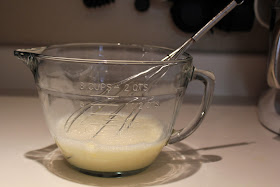After our success with starting April on solid food with homemade rice cereal, I moved on to wheat cereal. She loved it!!
Unfortunately, WinCo doesn’t carry wheat cereal in the bulk bins, so I have to buy boxed Cream of Wheat. The box even has directions for making cream of wheat for infants and toddlers. I ignore these directions and simply follow the regular directions on the back, using water and omitting the salt.

The key to making wheat cereal for babies just starting out on solid foods is to make sure there are no lumps (especially if you will be using a
Boon spoon
).
Be sure to whisk vigorously and constantly while slowly adding the wheat.
 |
You definitely want it really smooth
if you're using a Boon spoon. |
While Cream of Wheat is milled fine enough that it doesn’t need to be puréed before feeding it to your baby, keep in mind that he/she may not like the
texture.
If your baby rejects the unpuréed cereal, try running it through the food processor to make it smoother.
 Wheat Cereal for Baby
Wheat Cereal for Baby (from back of Cream of Wheat box)
2 c. water
1/3 c. Cream of Wheat
Bring water to boil. Gradually add Cream of Wheat, whisking constantly and vigorously until blended. Return to boil. Reduce heat to low; simmer, uncovered, 2 ½ minutes or until thick, stirring frequently. Add breast milk, formula, or water to achieve desired consistency.
A few days after introducing the wheat cereal, we moved on to oatmeal.
Once again, you do not need to buy special baby oatmeal.
I simply use the same oatmeal I make for the rest of my family.
This is usually steel-cut oats.
You can find my slow cooker method
here.
If I do not have any steel-cut oats made, I sometimes cook rolled oats in the microwave.
Regardless of what type of oats you use to make your oatmeal, you can make it baby-friendly. Simply stick it in the food processor with some liquid.
 Rolled (Old-Fashioned) Oatmeal for Baby
Rolled (Old-Fashioned) Oatmeal for Baby1¾ c. water
1 c. rolled oats
Place water and oats in microwave-safe dish. Microwave about 3 minutes, or until oats have absorbed water. Purée in food processor with liquid to desired consistency.

Regardless of what type of baby food I’m making, I like to make a lot at one time. This minimizes overall preparation time and ensures that I always have some on hand when April is hungry.
 |
| April can hardly wait for her next bite of oatmeal! |
Homemade baby cereals will keep good in the fridge for up to a week if made with water.
If breast milk has been added, follow current
storage time recommendations.
As of the time that I am writing this, it is recommended that breast milk only be refrigerated for up to three days and frozen for one month in a freezer attached to a fridge or three to six months in a deep freezer.
These recommendations are always changing and I usually store milk longer than that.
Once I’ve packaged up the cereal I want to keep in the refrigerator for the next few days, I freeze the rest. Be sure to freeze it in portions that will be used within the recommended storage period. One convenient way to do this is to freeze it in ice cube trays. I simply scoop it in one-tablespoon portions. Once it is frozen solid, I store them in a zip-top bag. Simple pull out the desired number of cereal cubes and microwave until warm, but not hot. I also use these to cool freshly made cereal (breast milk ice cubes work too). This ice cube tray method is great when you want to mix small portions of different foods.
 |
| I use cereal cubes to cool fresh batches. |

Most official documents you read will tell you to never microwave a bottle or baby food. The reason for this is that the physics behind microwave cooking causes hot spots which can burn baby’s mouth. Just use common sense and caution. April doesn’t get bottles, so that’s not an issue in our house, but I do use the microwave to heat and thaw her food. Just be sure to thoroughly mix any food that has been heated in the microwave to do away with any hot spots then check the temperature. Because our fingers take so much abuse, they are not the best judge of true temperature. It is better to check baby food temperature on your wrist, lip, or tongue.
Be sure to check back next weekend when I talk about feeding April grits. And we may be starting veggies this week!
















































